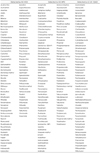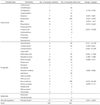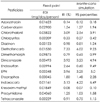Abstract
This paper specifically discusses the risk assessment on the pesticide residues in vegetables collected from traditional markets, big marts and departments in the southern part of Seoul. Vegetable samples were 6,583 cases from January to December in 2009. Monte-Carlo simulation was used to calculate the uncertainty for the risk index using pesticide residues, average dietary intake for vegetables and acceptable daily intake. Deterministic risk indexes were 7.33% of diethofencarb, 5.13% of indoxacarb, 3.96% of EPN, 3.92% of diniconazole and 3.09% of chlorothalonil, respectively. And other pesticides were below 3%. Distributions of risk indexes obtained by the Monte-Carlo simulations were similar to the deterministic values, even though the confidence intervals for 95% were very wide. We confirmed that health risks caused by eating vegetables exceeded maximum residue limits of pesticide are very low and the population is generally safe, judging from the risk indexes located between 0.07 to 9.49%.
Figures and Tables
References
1. Seoul Metropolitan Government Research Institute of Public Health and Environment. The symposium on the management of toxic materials in food. Present & future of the management for pesticide residues in vegetables. 2008. 43.
2. Chun OK, Lee YW. A Study on the of Pesticide Exposure by Food Intake. J Food Hyg Saf. 1999. 14(2):201–215.
3. Lee HM, Han JY, Yoon EK, Kim HM, Hwang IG, Choi DM, Lee KB, Won KP, Song IS, Park SE, Shin DC. Cumulative risk assessment of organophosphorus pesticides in the diet. J Food Hyg Saf. 2001. 16(1):1–26.
4. Han KT, Park HJ, Lee KS, Kim IJ, Kim KS, Cho SM. Pesticide residue survey and risk assessment of fruits in Daejeon. Korean J Environ Agric. 2002. 21(4):279–285.

5. Korea Food and Drug Administration. Korea Food Code. 2009.
6. Lee SM, Papathakis Michael L, Feng Hsiaoming C, Gray FH, Joyce EC. Multipesticide residue method for fruits and vegetables. Fresenius J Anal Chem. 1991. 339(6):376–383.

7. Pyo HS, Park SR. Environmental analysis & human health risk assessment (1)-Analysis & risk assessment of chlorinated disinfection by-products in drinking Water. Analytical Science & Technology. 2000. 13(6):89–96.
8. Korea Food and Drug Administration. Pesticide Residue Database. 2010. Available from: http://fse.foodnara.go.kr/residue/pesticides/pesticides_info.jsp.
9. Korea Research Institute of Standard and Science. Report of 5th Size Korea. 2004.
10. Ministry of Health and Welfare. The Third Korea National Heaith & Nutrition Examination Survey. 2005.
11. EPA. Anticipated residues for chronic dietary exposure assessment for chlorpyrifos RED. 1999.
12. EPA. Human risk assessment-chlorpyrifos. 2000.
13. EPA. Toxicology chapter for chlorpyrifos. 2000.
14. Lee SR, Lee MK, Kim NH. Computation of theoretical maximum daily intake and safety index of pesticides by Korean population. Korean J Food Sci Technol. 1995. 27(4):618–624.
15. Lee MG, Lee SR. Computation of theoretical maximum daily intake of pesticides by Korean population. Food Sci Biotecnol. 2001. 10(2):115–122.
16. Lee SR, Lee MG. Present status and remedial actions with regard to legal limits of pesticide residues in Korea. Korean J Environ Agric. 2001. 20(1):34–43.
17. Lee SR. Pesticides Problems and Regulatory Aspects in USA. Korean J Environ Agric. 1991. 10(2):178–196.
18. FDA. Food and Drug Administration pesticides programme-Residues monitering. 2000.
19. Kim HY, Yoon SH, Park HJ, Lee JH, Gwak IS, Moon HS, Song MH, Jang YM, Lee MS, Park JS, Lee KH. Monitoring of residual pesticides in commercial agricultural products in Koea. Korean J Food Sci Technol. 2007. 39(3):237–245.
20. Ronchin M, Mariani F, Visentin S, Colosio C, Salamana M, Carreri V, Maroni M. Risk assessment of dietary pesticide intake and the EDI/ADI ratio in the post marketing phase. 2002. In : 4th European pesticide residues workshop-pesticide in food and drink;
21. Lee MG. Risk assessment of organophosphorus pesticides residues in Korean foods [dissertation]. 1995. Seoul: Ewha Womans University.




 PDF
PDF ePub
ePub Citation
Citation Print
Print













 XML Download
XML Download